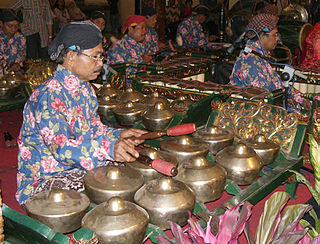
Gamelan is the traditional ensemble music of the Javanese, Sundanese, and Balinese peoples of Indonesia, made up predominantly of percussive instruments. The most common instruments used are metallophones played by mallets and a set of hand-played drums called kendhang/Kendang, which register the beat. The kemanak and gangsa are commonly used gamelan instruments in Bali. Other instruments include xylophones, bamboo flutes, a bowed instrument called a rebab, a zither-like instrument siter and vocalists named sindhen (Female) or gerong (Male).
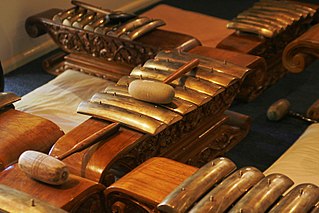
A metallophone is any musical instrument in which the sound-producing body is a piece of metal, consisting of tuned metal bars, tubes, rods, bowls, or plates. Most frequently the metal body is struck to produce sound, usually with a mallet, but may also be activated by friction, keyboard action, or other means.

Pelog is one of the essential tuning systems used in gamelan instruments that has heptatonic scale. The other, older, scale commonly used is called slendro. Pelog has seven notes, but many gamelan ensembles only have keys for five of the pitches. Even in ensembles that have all seven notes, many pieces only use a subset of five notes, sometimes the additional 4th tone is also used in a piece like western accidentals.
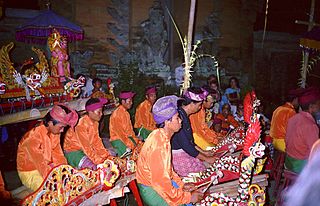
Jegog is a form of gamelan music indigenous to Bali, Indonesia, played on instruments made of bamboo. The tradition of jegog is centered in Jembrana, a region in Western Bali. In recent years jegog has started to become popular in other regions of Bali with a few groups being established in central Bali to entertain tourists. International interest has been spread by tourists visiting Bali and by recordings. There are virtually no ensembles outside of Bali with the exception of at least two groups in Japan, one in the United States and one in Germany. Jegog music is very fast, loud, rhythmic and precise. Pieces last from a few minutes to as long as thirty minutes.

Gamelan gong kebyar is a style or genre of Balinese gamelan music of Indonesia. Kebyar means "to flare up or burst open", and refers to the explosive changes in tempo and dynamics characteristic of the style. It is the most popular form of gamelan in Bali, and its best known musical export.

The Music of Bali, Bali is an Indonesian island that shares in the gamelan and other Indonesian musical styles. Bali, however, has its own techniques and styles, including kecak, a form of singing that imitates the sound of monkeys. In addition, the island is home to several unique kinds of gamelan, including the gamelan jegog, gamelan gong gede, gamelan gambang, gamelan selunding and gamelan semar pegulingan, the cremation music angklung and the processional music bebonangan. Modern popular styles include gamelan gong kebyar, dance music which developed during the Dutch occupation and 1950s era joged bumbung, another popular dance style. In Balinese music you can also hear metallophones, gongs and xylophones.

Joged bumbung is a style of gamelan music from Bali, Indonesia on instruments made primarily out of bamboo. The ensemble gets its name from joged, a flirtatious dance often performed at festivals and parties. This style of Gamelan is especially popular in Northern and Western Bali, but is easily found all over the island. Unlike many styles of Balinese Gamelan which have sacred roles in religious festivals, Joged music is much more secular, and in many ways has become the folk music of Bali. With the rapid rise of tourism in recent decades, Joged music is now often found being performed at hotels and restaurants.

The angklung is a musical instrument from the Sundanese people in Indonesia made of a varying number of bamboo tubes attached to a bamboo frame. The tubes are carved to have a resonant pitch when struck and are tuned to octaves, similar to Western handbells. The base of the frame is held in one hand, while the other hand shakes the instrument, causing a repeating note to sound. Each performer in an angklung ensemble is typically responsible for just one pitch, sounding their individual angklung at the appropriate times to produce complete melodies.

Kotekan is a style of playing fast interlocking parts in most varieties of Balinese Gamelan music, including Gamelan gong kebyar, Gamelan angklung, Gamelan jegog and others.
The ugal is an instrument in the Indonesian gamelan orchestra. It is a bronze metallophone played one handed with a small hammer, often in a dance-like manner. There are usually ten keys, giving a maximum range spanning about two octaves. Like the gangsa and gendér, they are suspended over tuned bamboo resonators.
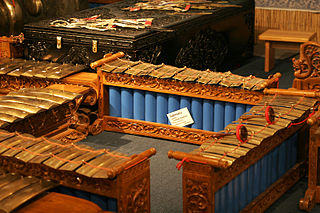
A gendèr is a type of metallophone used in Balinese and Javanese gamelan music. It consists of 10 to 14 tuned metal bars suspended over a tuned resonator of bamboo or metal, which are tapped with a mallet made of wooden disks (Bali) or a padded wooden disk (Java). Each key is a note of a different pitch, often extending a little more than two octaves. There are five notes per octave, so in the seven-note pélog scale, some pitches are left out according to the pathet. Most gamelans include three gendèr, one for sléndro, one for pelog pathet nem and lima, and one for pelog pathet barang.

The reyong is a musical instrument used in Balinese gamelan. It consists of a long row of metal gongs suspended on a frame. In gamelan gong kebyar, it is played by four players at once, each with two mallets.

Gamelan beleganjur is one of the most popular styles of gamelan music in Bali. Its closest Western analogue is probably the Western military band.

The slenthem is an Indonesian metallophone which makes up part of a Javanese gamelan orchestra. The slenthem is part of the gendér family. It consists of a set of bronze keys comprising a single octave: there are six keys when playing the slendro scale and seven when playing the pelog. These keys are suspended by leather cords over individual bamboo tube resonators in a wooden frame, which are cut so that the placement of the bamboo's node causes the functional length of the resonator to be shorter for higher notes. The instrument is played by striking the keys with a mallet, called a tabuh, which has a short handle and a thin wooden disk edged in cloth or rubber. One hand is left free to dampen notes. It is a low-pitched instrument with a softer sound than the saron demung.

Gamelan Sekar Jaya is a Balinese gamelan ensemble located in the San Francisco Bay Area. It has been called "the finest Balinese gamelan ensemble outside of Indonesia" by Indonesia's Tempo Magazine. It performs the music and dance of Bali in many different genres of Balinese gamelan, mainly gamelan gong kebyar, gamelan angklung, gender wayang, and gamelan jegog. Past performances have also featured ensembles playing in other styles as well, including gamelan joged bumbung, kecak, gender batel, gamelan gambuh, genggong, and beleganjur. GSJ has also performed contemporary pieces featuring instruments from the Western tradition.

A gambang, properly called a gambang kayu is a xylophone-like instrument used among people of Indonesia in gamelan and kulintang, with wooden bars as opposed to the metallic ones of the more typical metallophones in a gamelan. A largely obsolete instrument, the gambang gangsa, is a similar instrument made with metal bars.

Gamelan gong gede, meaning "gamelan with the large gongs", is a form of the ceremonial gamelan music of Bali, dating from the court society of the fifteenth and sixteenth centuries, associated historically with public ceremonies and special occasions such as temple festivals.

Gamelan gender wayang is a style of gamelan music played in Bali, Indonesia. It is required for wayang and most sacred Balinese Hindu rituals. The smallest of gamelan ensembles, it requires only two players and is complete at four, the additional instruments doubling an octave above. Like other gamelan genres, it incorporates delicate interlocking melodies and active contrapuntal movement, yet poses unique challenges in technique and composition.

A calung is a bamboo tube xylophone used in the Indonesian music of Sundanese, Banyumasan, and Balinese. The calung (instrument) consists of multiple bamboo tubes which are struck at the base to produce a woody sound. In the Balinese Gamelan gong kebyar, the metallophone Jublag can also be known as Calung, it has a one-octave range, and is generally utilized to play mid-range melodies.
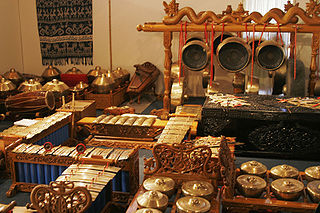
A gong chime is a generic term for a set of small, high-pitched bossed pot gongs. The gongs are ordinarily placed in order of pitch, with the boss upward on cords held in a low wooden frame. The frames can be rectangular or circular, and may have one or two rows of gongs. They are played by one to four musicians, each using two padded sticks to strike them. They are an important instrument in many Southeast Asian musical ensembles, such as Indonesian gamelan, kulintang, or Thai pi phat. For this reason, such ensembles are sometimes called "gong chime ensembles" or "gong chime orchestras," and the broad variety of music "gong chime music."




















